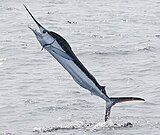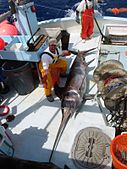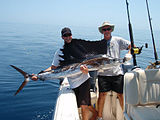Billfish

Billfish are pelagic and highly migratory. They are found in all oceans,[3] although they usually inhabit tropical and subtropical waters; swordfish are found in temperate waters as well. Billfish use their long spears or swordlike upper jaws or beaks to slash at and stun prey during feeding. Their bills can also be used to spear prey, and have been known to spear boats (probably accidentally), but they are not normally used in that way. They are highly valued as gamefish by sports fishermen.
Species
The term billfish refers to the fishes of the families Xiphiidae and Istiophoridae. These large fishes are "characterized by the prolongation of the upper jaw, much beyond the lower jaw into a long rostrum which is flat and swordlike (swordfish) or rounded and spearlike (sailfishes, spearfishes and marlins)."[4]True billfish
There are 12 species of true billfishes, divided into two families and four genera. One family, Xiphiidae, contains only one species, the swordfish Xiphias gladius, and the other family, Istiophoridae contains 11 species in three genera, including marlin, spearfish and sailfish.[4] There is controversy about whether the Indo-Pacific blue marlin, Makaira mazara, is the same species as the Atlantic blue marlin, Makaira nigricans. FishBase follows Nakamura (1985)[4] in recognizing Makaira mazara as a distinct species, "chiefly because of differences in the pattern of the lateral line system".[5]| This article is one of a series on |
| Commercial fish |
|---|
| Large pelagic |
| billfish, bonito mackerel, salmon shark, tuna |
| Forage |
| anchovy, herring menhaden, sardine shad, sprat |
| Demersal |
| cod, eel, flatfish pollock, ray |
| Mixed |
| carp |
| [hide]Billfish species | |||||||||||
|---|---|---|---|---|---|---|---|---|---|---|---|
| Family | Genus | Common name | Scientific name | Maximum length | Common length | Maximum weight | Maximum age | Trophic level | FishBase | FAO | IUCN status |
| Xiphiidae | Xiphias | Swordfish | Xiphias gladius (Linnaeus, 1758) | 455 cm | 300 cm | 650 kg | years | 4.49 | [6] | [7] | |
| Istiophoridae | Istiophorus Sailfish | Atlantic sailfish | Istiophorus albicans (Latreille, 1804) | 315 cm | cm | 58.1 kg | 17 years[9] | 4.50 | [10] | Not assessed | |
| Indo-Pacific sailfish | Istiophorus platypterus (Shaw, 1792) | 340 cm | cm | 100 kg | years | 4.50 | [11] | [12] | |||
| Makaira | Black marlin | Makaira indica -Istiompax indica?(Cuvier, 1832) | 465 cm | 380 cm | 750 kg | years | 4.50 | [13] | |||
| Indo-Pacific blue marlin | Makaira mazara (Jordan and Snyder, 1901) | cm | cm | kg | years | 4.46 | [5] | Not assessed | |||
| Atlantic blue marlin | Makaira nigricans (Lacépède, 1802) | 500 cm | 290 cm | 820 kg | years | 4.50 | [15] | ||||
| Tetrapturus | White marlin | Tetrapturus albidus/Kajikia albida Poey, 1860 | 300 cm | 210 cm | 82.5 kg | years | 4.48 | [16] | |||
| Shortbill spearfish | Tetrapturus angustirostris Tanaka, 1915 | 200 cm | cm | 52 kg | years | 4.50 | [18] | ||||
| Striped marlin | Tetrapturus audax/Kajikia audax (Philippi, 1887) | 350 cm | cm | 200 kg | years | 4.58 | [20] | [21] | |||
| Roundscale spearfish | Tetrapturus georgii Lowe, 1841 | 184 cm | cm | 24 kg | years | 4.37 | [23] | ||||
| Mediterranean spearfish | Tetrapturus belone Rafinesque, 1810 | 240 cm | 200 cm | 70 kg | years | 4.50 | [24] | ||||
| Longbill spearfish | Tetrapturus pfluegeri Robins and de Sylva, 1963 | 254 cm | 165 cm | 58 kg | years | 4.28 | [26] | ||||
| True billfishes | |||||||||
Billfish-like fishes
A number of other fishes have pronounced bills or beaks, and are sometimes referred to as billfish. However, they are not true billfish. Halfbeaks look somewhat like miniature billfishes, and the sawfish, which is shark, has a spectacular rostrum shaped like a chain saw. Needlefish are sometimes confused with billfishes, but they are "easily distinguished from the true billfishes by having both jaws prolonged, the dorsal and anal fins both single and similar in size and shape, and the pelvic fins inserted far behind the pectorals."[4][edit] Structure and function of the bill
Billfish have a long, bony, spear-shaped bill, sometimes called a snout, beak or rostrum. The swordfish has the longest bill, about one-third its body length. Like a true sword, it is smooth, flat, pointed and sharp. The bills of other billfish are shorter and rounder, more like spears.[28]Billfish normally use their bills to slash at schooling fish. They swim through the fish school at high speed, slashing left and right, and then circle back to eat the fish they stunned. Adult swordfish have no teeth, and other billfish have only small file-like teeth. They swallow their catch whole, head-first. Billfish don't normally spear with their bills, though occasionally a marlin will flip a fish into the air and bayonet it. Given the speed and power of these fish, when they do spear things the results can be dramatic. Predators of billfish, such as great white and marko sharks, have been found with billfish spears embedded in them.[29][30][31] Pelagic fish generally are fascinated by floating objects, and congregate about them.[32] Billfish can accidentally impale boats and other floating objects when they pursue the small fish that aggregate around them.[31] Care is needed when attempting to land a hooked billfish. Many fisherman have been injured, some seriously, by a billfish thrashing its bill about.[30]
Other characteristics
| Striped Marlin Bait Ball You | |
Like scombroids (tuna, bonito and mackerel), billfish have both the ability to migrate over long distances, efficiently cruising at slow speeds, and the ability to generate rapid bursts of speed. These speed bursts can be quite astonishing, and the Indo-Pacific sailfish has been recorded making a burst of 68 miles per hour (110 km/h), nearly top speed for a cheetah and the highest speed ever recorded for a fish.[29]
Some billfish also descend to considerable mesopelagic depths. They have sophisticated swim bladders which allow them to rapidly compensate for pressure changes as the depth changes. This means that when they are swimming deep, they can return swiftly to the surface without problems.[33] "Like the large tuna, some billfish maintain their body temperature several degrees above ambient water temperatures; this elevated body temperature increases the efficiency of the swimming muscles, especially during excursions into the cold water below the thermocline."[31]
In 1936 the British zoologist James Gray posed a conundrum which has come to be known as Gray's paradox. The problem he posed was how dolphins can swim and accelerate so fast when it seemed their muscles lacked the needed power.[34] If this is a problem with dolphins it is an even greater problem with billfish such as swordfish, which swim and accelerate faster than dolphins. In 2009, Taiwanese researchers from the National Chung Hsing University introduced new concepts of "kidnapped airfoils and circulating horsepower" to explain the swimming capabilities of swordfish. The researchers claim this analysis also "solves the perplexity of dolphin’s Gray paradox". They also assert that swordfish "use sensitive rostrum/lateral-line sensors to detect upcoming/ambient water pressure and attain the best attack angle to capture the body lift power aided by the forward-biased dorsal fin to compensate for most of the water resistance power."[35]
Billfish have prominent dorsal fins. Like tuna, mackerel and other scombroids, billfish streamline themselves by retracting their dorsal fins into a grove in their body when they swim.[29] The shape, size, position and colour of the dorsal fin varies with the type of billfish, and can be a simple way to identify a billfish species. For example, the white marlin has a dorsal fin with a curved front edge and is covered with black spots. The huge dorsal fin, or sail of the sailfish is kept retracted most of the time. Sailfish raise them if they want to herd a school of small fish, and also after periods of high activity, presumably to cool down.[29][36]
[edit] Distribution and migration
Billfish occur worldwide in temperate and tropical waters. They are highly migratory oceanic fish, spending much of their time in the epipelagic zone of international water following major ocean currents.[29][31] Migrations are linked to seasonal patterns of sea surface temperatures.[37] They are sometimes referred to as "rare event species" because the areas they roam over in the open seas are so large that researchers have difficulty locating them. Little is known about their movements and life histories, so assessing how they can be sustainably managed is not easy.[38][39]Unlike coastal fish, billfish usually avoid inshore waters unless there is a deep dropoff close to the land.[30] Instead, they swim along the edge of the continental shelf where cold nutrient rich upwellings can fuel large schools of forage fish. Billfish can be found here, cruising and feeding "above the craggy bottom like hawks soaring along a ridge line".[40]
Commercial fishing
Recreational fishing
Over the years, billfish tournaments have transformed into big business enterprises. Many prestigious tournaments now have enormous calcuttas and purses as well as large numbers of participating anglers. With huge purses and egos on the line, concern often arises whether all participants are adhering to the letter of the rules.
– IGFA Conservation Director, Jason Schratwieser [42]
– IGFA Conservation Director, Jason Schratwieser [42]
See also: Big game fishing and Marlin fishing
Billfish are among the most coveted of big gamefish, and major recreational fisheries cater to the demand.[39] In North America, "the apex of the salt water pursuits is billfishing, the quest for elusive blue marlin and sailfish in the deep blue water about 60 miles out."[40] A lot of resources are committed to the activity, particularly in the construction of private and charter billfishing boats to participate in the billfishing tournament circuit. These are expensive purpose-built offshore vessels with powerfully driven deep sea hulls. They are often built to luxury standards and equipped with many technologies to ease the life of the deep sea recreational fisherman, including outriggers, flying bridges and fighting chairs, and state of the art fishfinders and navigation electronics.[40]The boats cruise along the edge of the continental shelf where billfish can be found down to 200 metres (600 ft), sometimes near weed lines at the surface and submarine canyons and ridges deeper down. Commercial fishermen usually use drift nets or longlines to catch billfish, but recreational fishermen usually drift with bait fish or troll a bait or lure. Billfish are caught deeper down the water column by drifting with live bait fish such as ballyhoo, striped mullet or bonito. Alternatively, they can be caught by trolling at the surface with dead bait or trolling lures designed to imitate bait fish.[43]
Most recreational fishermen now tag and release billfish.[40] A 2003 study surveyed 317,000 billfish known to have been tagged and released since 1954. Of these, 4122 were recovered. The study concluded that, while tag and release programs have limitations, they provided important information about billfish that cannot currently be obtained by other methods.[31][39]
As food
Billfish make good eating fish, and are high in omega-3 oils. Blue marlin has a particularly high oil content.[44] However, because billfish have high trophic levels, near the top of the food web, they also contain significant levels of mercury and other toxins. According to the United States Food and Drug Administration, swordfish is one of four fishes, along with tilefish, shark, and king mackerel, that children and pregnant women should avoid due to high levels of methylmercury found in these fish and the consequent risk of mercury poisoning.[45] [46]| Nutritional value per 100 g (3.5 oz) | |
|---|---|
| Energy | 144 kJ (34 kcal) |
| Fat | 6.65 g |
| Protein | 19.66 g |
| Water | 73.38 g |
| Vitamin A | 120 IU |
| Vitamin D | 558 IU (93%) |
| Calcium | 5 mg (1%) |
| Iron | 0.38 mg (3%) |
| Magnesium | 29 mg (8%) |
| Phosphorus | 255 mg (36%) |
| Potassium | 418 mg (9%) |
| Sodium | 81 mg (5%) |
| Zinc | 0.66 mg (7%) |
| Percentages are relative to US recommendations for adults. Source: USDA Nutrient Database | |
| [hide]Comparative mercury levels[47] | |||||||
|---|---|---|---|---|---|---|---|
| Species | Mean ppm | ||||||
| Tilefish | 1.450 | Gulf of Mexico | |||||
| Swordfish | 0.995 | ||||||
| Shark | 0.979 | ||||||
| King mackerel | 0.730 | ||||||
| Bigeye tuna | 0.689 | Fresh/frozen | |||||
| Orange roughy | 0.571 | ||||||
| Marlin * | 0.485 | ||||||
| King mackerel | 0.182 | South Atlantic | |||||
| Herring | 0.084 | ||||||
| Flatfish * | 0.056 | Flounder, plaice and sole | |||||
| Catfish | 0.025 | ||||||
| Salmon * | 0.022 | Fresh/frozen | |||||
| Sardine | 0.013 | ||||||
| Tilapia * | 0.013 | ||||||
| * indicates methylmercury only was analyzed (all other results are for total mercury) | |||||||
| Billfish as food | |||||||||
| |||||||||
Conservation
Billfish are exploited both as food and as game fish. Marlin and sailfish are eaten in many parts of the world, and many sport fisheries target these species. Swordfish are subject to particularly intense fisheries pressures, and although their survival is not threatened worldwide, they are now comparatively rare in many places where once they were abundant. The istiophorid billfishes (marlin and spearfish) also suffer from intense fishing pressures. High mortality levels occur when they are caught incidentally by longline fisheries targeting other fish.[48] Overfishing continues to "push these declines further in some species".[49] Because of these concerns about declining populations, sport fishermen and conservationists now work together to gather information on billfish stocks and implement programs such as catch and release, where fish are returned to the sea after they have been caught. Billfish caught within 320 km (200 m) of the US coast now have to be released. However, the process of catching them can leave them too traumatised to recover.[29] Studies have shown that circle fishing hooks do much less damage to billfish than the traditional J-hooks, yet they are at just as effective for catching billfish. This is good for conservation, since it improves survival rates after release.[50][51]The stocks for individual species in billfish longline fisheries can "boom and bust" in linked and compensatory ways. For example, the Atlantic catch of blue marlin declined in the 1960s. This was accompanied by an increase in sailfish catch. The sailfish catch then declined from the end of the 1970s to the end of the 1980s, compensated by an increase in swordfish catch. As a result, overall billfish catches remained fairly stable.[52]
"Many of the world’s fisheries operate in a data poor environment that precludes predictions about how different management actions will affect individual species and the ecosystem as a whole."[53] In recently years pop-up satellite archival tags have been used to monitor billfish. The capability of these tags to recover useful data is improving, and their use should result in more accurate stock assessments.[54] In 2011, a group of researchers claimed they have, for the first time, standardized all available data about scombrids and billfishes so it is in a form suitable for assessing threats to these species. The synthesis shows that those species which combine a long life with a high economic value, such as the Atlantic blue marlin and the white marlin, are generally threatened. The combination puts such species in "double
Source: http://en.wikipedia.org/
More Stories: http://blackboxfishtalk.blogspot.com/















No comments:
Post a Comment